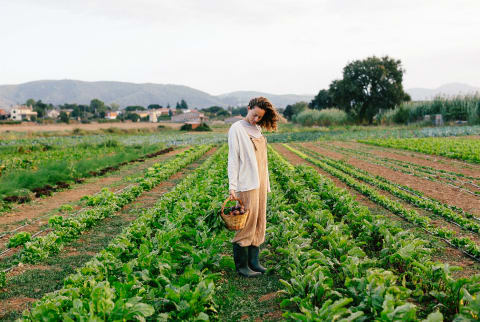Advertisement
We Could Have Less Than 60 Years Of Farming Left — Unless We Support This Growing Movement


Sixty years. That's how long U.N. officials said we have until all the world's topsoil degrades to the point that it's no longer useful for farming (and this was back in 2014, so it's more like 55 years now).
Massive farms—the kinds that lean on chemical pesticides, large tilling machines, and other growing techniques that strip the ground of nutrients—are one of the biggest threats to our soil. As the global population rises, more hungry mouths to feed will likely mean more of these environmentally damaging growing practices.
On the other end of the spectrum, you'll find regenerative farming that actually mimics nature to restore soil health by pumping nutrients back into the ground. (You can learn more on how it works here.) Regenerative agriculture is one antidote to this bleak 55-year forecast, and it could spell a very different future: one in which our land is filled with healthy, nutrient-rich foods and acts as a built-in buffer against climate change (when it's in tiptop shape, soil can actually absorb carbon and other pollutants from the ground up, after all).
The regenerative movement has come a long way in the last five years—but there's still lots more to be done. Here's what industry insiders had to say about what the average person can do to help move it along.
How can I buy food that doesn't deplete the world's soil?
As mbg reported in this year's annual wellness forecast (in which we named the regenerative movement as one trend to watch!), a 2017 study found that 60% of people were on board with shifting their buying habits to support regeneratively grown food. The problem is that this kind of food isn't so easy to find in your local grocery section.
As it stands right now, there is no verifiable label for regeneratively grown food (though major companies like Danone, Unilever, Patagonia, and General Mills are putting dollars behind creating one). So with the exception of select products from brands like Annie's, you'll find very little with the word "regenerative" printed on the label.
"It's not like you can walk into most stores and see an apple grown regeneratively," says Larry Kopald, founder and president of The Carbon Underground, a nonprofit dedicated to reversing climate change that is also working on a label. When I asked him when people could expect to see a regenerative certification, he said he couldn't imagine it would be within the next six to 12 months. It's a lengthy process for farmers to clean up their growing practices and get certified—and then there's the task of updating packaging to reflect the new designation.
Gabe Kennedy, the co-founder of Plant People, a line of CBD products grown using regenerative practices, points out another confounding factor: "Regenerative agriculture isn't tied to any particular crop. [It is] a holistic methodology of farming that values soil health, animal welfare, and social fairness with a goal of enhancing the whole agriculture system."
This means every regenerative farm will look different, and there's no one-size-fits-all model for success. To find regeneratively grown in your area, therefore, requires getting really close to your food source.
The dirt on supporting regenerative agriculture in your area.
"Start by trying to understanding your place or the farmland nearest to you," recommends Zach Wolf, the farm manager at Caney Fork Farms in Carthage, Tennessee. For example, he says, his region of Tennessee gets a lot of rain and shade from trees. This makes it easier for them to work with nature to raise crops and cattle than it would be for a farmer in, say, a super-dry desert climate in California.
Gathering this information and learning about regenerative progress in your area will probably require talking to your local farmers, or grocery store managers if you don't have a farmers market that's easily accessible.
"The best recommendation until we have the regenerative standard is to ask more questions and get closer to your food source," says Lauren Tucker, the executive director of Kiss the Ground, a group that is pushing for "global regeneration." Tucker and her team put out a 30-page purchasing guide with sample questions to ask to help encourage these conversations, which you can access here.
Even if the person you're talking to isn't familiar with regenerative practices, at least your question put it on their radar. "Let them know the consumers are talking about [regeneratively grown food] because more and more farmers are starting to grow it," says Kopald. "It will create the distribution for what they're growing."
While it will likely require an extra step to find regenerative food, and an extra dollar to buy it until it becomes more widespread, David Karr, co-founder of Guayakí Yerba Mate, another company that employs regenerative practices, reminds us that "You pay now or you pay later." If you're able to support the industry, it could pay dividends to the planet—not to mention your health—down the line.
"We now understand that the closer we all get (literally) to biologically diverse soil, the better our immune and digestive health becomes1," says Wolf. "This would be the ultimate goal of the regenerative agricultural movement: to build the link between land health and human health so that final link has been made, all the way from soil to stomach."
Watch Next
Enjoy some of our favorite clips from classes
Enjoy some of our favorite clips from classes
What Is Meditation?
Mindfulness/Spirituality | Light Watkins
Box Breathing
Mindfulness/Spirituality | Gwen Dittmar
What Breathwork Can Address
Mindfulness/Spirituality | Gwen Dittmar
The 8 Limbs of Yoga - What is Asana?
Yoga | Caley Alyssa
Two Standing Postures to Open Up Tight Hips
Yoga | Caley Alyssa
How Plants Can Optimize Athletic Performance
Nutrition | Rich Roll
What to Eat Before a Workout
Nutrition | Rich Roll
How Ayurveda Helps Us Navigate Modern Life
Nutrition | Sahara Rose
Messages About Love & Relationships
Love & Relationships | Esther Perel
Love Languages
Love & Relationships | Esther Perel











